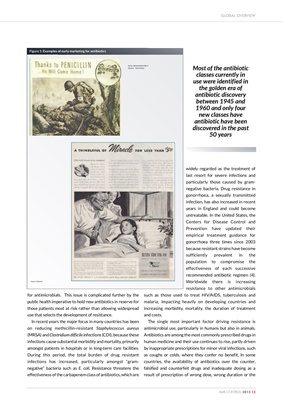
for antimicrobials. This issue is complicated further by the
public health imperative to hold new antibiotics in reserve for
those patients most at risk rather than allowing widespread
use that selects the development of resistance.
In recent years the major focus in many countries has been
on reducing methicillin-resistant Staphylococcus aureus
(MRSA) and Clostridium difficileinfections (CDI), because these
infections cause substantial morbidity and mortality, primarily
amongst patients in hospitals or in long-term care facilities.
During this period, the total burden of drug resistant
infections has increased, particularly amongst "gramnegative"
bacteria such as E. coli. Resistance threatens the
effectiveness of the carbapenem class of antibiotics, which are
widely regarded as the treatment of
last resort for severe infections and
particularly those caused by gramnegative
bacteria. Drug resistance in
gonorrhoea, a sexually transmitted
infection, has also increased in recent
years in England and could become
untreatable. In the United States, the
Centers for Disease Control and
Prevention have updated their
empirical treatment guidance for
gonorrhoea three times since 2003
because resistant strains have become
sufficiently prevalent in the
population to compromise the
effectiveness of each successive
recommended antibiotic regimen (4).
Worldwide there is increasing
resistance to other antimicrobials
such as those used to treat HIV/AIDS, tuberculosis and
malaria, impacting heavily on developing countries and
increasing morbidity, mortality, the duration of treatment
and costs.
The single most important factor driving resistance is
antimicrobial use, particularly in humans but also in animals.
Antibiotics are among the most commonly prescribed drugs in
human medicine and their use continues to rise, partly driven
by inappropriate prescriptions for minor viral infections, such
as coughs or colds, where they confer no benefit. In some
countries, the availability of antibiotics over the counter,
falsified and counterfeit drugs and inadequate dosing as a
result of prescription of wrong dose, wrong duration or the
GLOBAL OVERVIEW
AMR CONTROL 2015 13
Figure 1: Examples of early marketing for antibiotics
Source: Unknown
Source: National World War 2
Museum - New Orleans Most of the antibiotic
classes currently in
use were identified in
the golden era of
antibiotic discovery
between 1945 and
1960 and only four
new classes have
antibiotic have been
discovered in the past
50 years